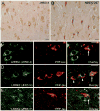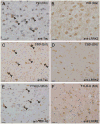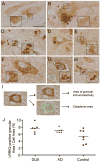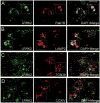Abnormal localization of leucine-rich repeat kinase 2 to the endosomal-lysosomal compartment in lewy body disease
- PMID: 19680143
- PMCID: PMC2768772
- DOI: 10.1097/NEN.0b013e3181b44ed8
Abnormal localization of leucine-rich repeat kinase 2 to the endosomal-lysosomal compartment in lewy body disease
Abstract
Missense mutations in the leucine-rich repeat kinase 2 (LRRK2) gene are the most common causes of both familial and sporadic forms of Parkinson disease and are also associated with diverse pathological alterations. The mechanisms whereby LRRK2 mutations cause these pathological phenotypes are unknown. We used immunohistochemistry with 3 distinct anti-LRRK2 antibodies to characterize the expression of LRRK2 in the brains of 21 subjects with various neurodegenerative disorders and 7 controls. The immunoreactivity of LRRK2 was localized in a subset of brainstem-type Lewy bodies (LBs) but not in cortical-type LBs, tau-positive inclusions, or TAR-DNA-binding protein-43-positive inclusions. The immunoreactivity of LRRK2 frequently appeared as enlarged granules or vacuoles within neurons of affected brain regions, including the substantia nigra, amygdala, and entorhinal cortex in patients with Parkinson disease or dementia with LBs. The volumes of LRRK2-positive granular structures in neurons of the entorhinal cortex were significantly increased in dementia with LBs brains compared with age-matched control brains (p < 0.05). Double immunolabeling demonstrated that these LRRK2-positive granular structures frequently colocalized with the late-endosomal marker Rab7B and occasionally with the lysosomal marker, the lysosomal-associated membrane protein 2. These results suggest that LRRK2 normally localizes to the endosomal-lysosomal compartment within morphologically altered neurons in neurodegenerative diseases, particularly in the brains of patients with LB diseases.
Figures






References
-
- Polymeropoulos MH, Lavedan C, Leroy E, et al. Mutation in the alpha-synuclein gene identified in families with Parkinson's disease. Science. 1997;276:2045–47. - PubMed
-
- Kitada T, Asakawa S, Hattori N, et al. Mutations in the parkin gene cause autosomal recessive juvenile parkinsonism. Nature. 1998;392:605–8. - PubMed
-
- Valente EM, Abou-Sleiman PM, Caputo V, et al. Hereditary early-onset Parkinson's disease caused by mutations in PINK1. Science. 2004;304:1158–60. - PubMed
-
- Bonifati V, Rizzu P, van Baren MJ, et al. Mutations in the DJ-1 gene associated with autosomal recessive early-onset parkinsonism. Science. 2003;299:256–59. - PubMed
-
- Zimprich A, Biskup S, Leitner P, et al. Mutations in LRRK2 cause autosomal-dominant parkinsonism with pleomorphic pathology. Neuron. 2004;44:601–7. - PubMed

